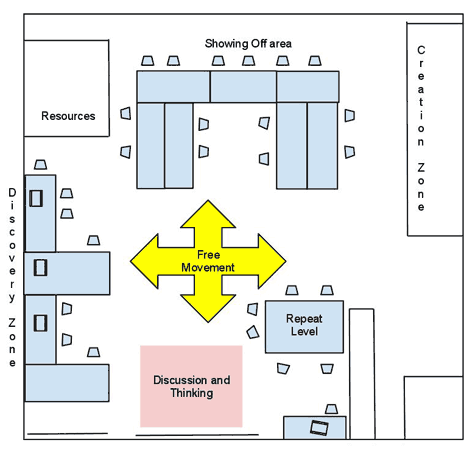
Combining voice, choice, and Common Core

Personalized learning begins with the learner and means the student drives their learning. To transform a classroom into a personalized learning environment means including student voice and student choice.
Student voice is difficult to hear in a traditional classroom where the teacher provides direct instruction and curriculum that is either provided for the teacher, adapted by the teacher, or designed by the teacher.
Student choice means students choose how they learn something and, possibly, what they learn.
Giving students voice and choice motivates them so they are engaged in learning and want to explore the topics in your classroom!
In a traditional classroom, in order to meet the Common Core Reading Literature standard for Key Ideas and Details, third graders may read or listen to the same text and are usually asked to respond the same way as everyone else in the class.
ELA-RL.3.1. Ask and answer questions to demonstrate understanding of a text, referring explicitly to the text as the basis for the answers.
In a personalized learning environment, each third grader and the teacher knows how the learner learns best and the ways that work best for them to demonstrate their learning. In this environment, the teacher might still present a story, but offers multiple ways to read, listen, and respond. The classroom would be set up with multiple stations to provide students with choices for how to learn and demonstrate understanding of a concept. For example:
Kevin McLaughlin, a primary teacher at Old Mill Primary School in the UK, divided his classroom into five zones to better enable students to approach and respond to concepts on their own terms.
In the Discussion and Thinking Zone, learners drop in to talk about their learning, find solutions, help each other, and just to think and chill out. This space is also used for whole class discussions and to share student work.
In the Discovery Zone, students use laptops and other technologies to discover answers, investigate and solve problems, collaborate on projects, and create presentations.
In the Show Off Zone, learners demonstrate their understanding through writing, presentation, and art work, choosing whatever medium they wish to present their work.
Students use the Repeat Level when they are “stuck” or need help, advice, and explanations.
In the Creation Zone, students write, edit, develop, and refine content presentations to demonstrate learning.
Kevin found that redesigning the learning environment to support student choice encouraged his students to take more ownership of their learning.

Setting up your classroom with learning zones makes it easy to introduce and read a story to the whole class, invite students to read different sections, and/or include the book in digital interactive format on the laptops or on mobile devices for students to read on their own during reading time.
When each learner with their teacher understands how they learn best, they become more involved in the learning process. The teacher can design a supportive learning environment that allows for each student to personalize how they access and engage with the content as well as how they demonstrate their understanding.
For example:
Personal Learner Profiles |
Learning Strategy |
|
John |
has a difficult time focusing on the text, is not able to write or speak descriptively, and is frustrated when writing his ideas down on paper. is comfortable with computers, good in math, and able to visualize numbers and patterns, but cannot sequence what is happening in a story and has trouble formulating good questions. |
The teacher and John agreed to pair him with David, who knows how to focus on a topic yet is not as comfortable with computers as John. They go to the Discovery Zone where John types on Google Docs while David guides their brainstorming, coming up with questions about the story. David helps John prioritize the questions until they come up with one to answer. John shows David how to use Google Docs so they can work together on the same document. |
Mary |
is a good storyteller who understands the moral and message of her own stories. loves to write stories but has long term memory problems which affect how she recounts stories she reads. likes to talk, raises her hand even though she may not know the answer, and asks lots of questions yet many do not pertain to the story. |
Mary decides to go to the Discussion and Thinking Zone to help her focus on the characters and setting of the story. The teacher sets up a digital storyboard that includes a set of visuals about the story. She then guides Mary and other students to sequence the story visually so they are able to understand the story and generate good questions. Mary then goes to the Discovery Zone to use a mobile device with the AudioNote app to write and/or record her questions. She then shares the questions with two other students who help her prioritize them. She then creates a slideshow using Wixie, answering the questions with text, images, and voice. |
Personalizing your classroom learning environment by giving students a voice and a choice helps you connect with student interest and passions, motivating them to explore topics and demonstrate understanding in a way that is most relevant to their experience. This makes classroom learning feel more relevant, connecting them to school and connecting school to their passions.

Follow us on Instagram for daily inspiration

Create a thought web, cluster, flowchart, or other graphic organizer for a lesson
8 first projects to get students using technology
Creative, digital book reviews
Fun and powerful ideas with animated characters

Wixie
Share your ideas, imagination, and understanding through writing, art, voice, and video.

Rubric Maker
Create custom rubrics for your classroom.

Pics4Learning
A curated, copyright-friendly image library that is safe and free for education.

Wriddle
Write, record, and illustrate a sentence.

Get creative classroom ideas delivered straight to your inbox once a month.
Topics